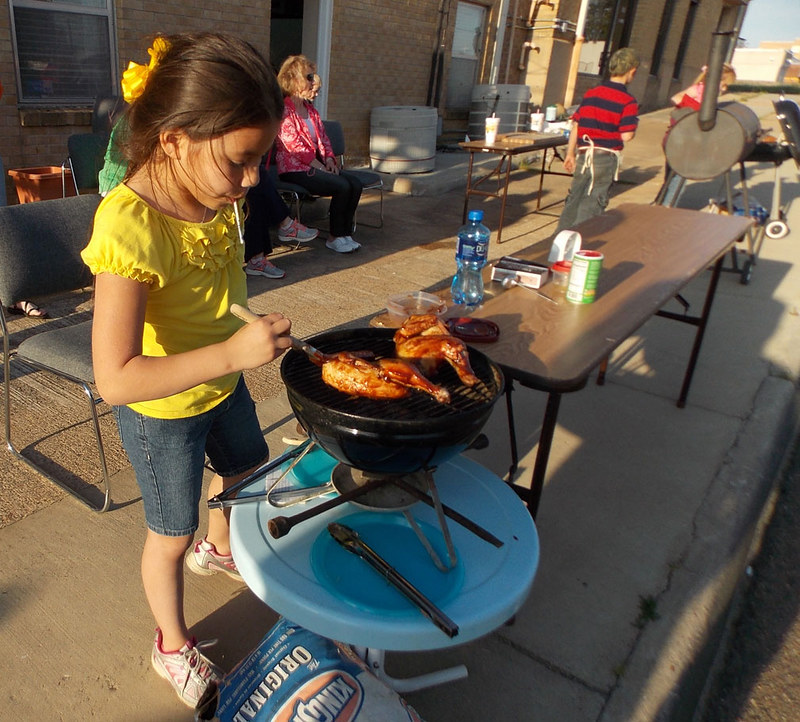HOLIDAY: Grilling safety starts with clean hands, work surfaces
Memorial Day is one of the two biggest grilling days of the year and before you fall completely under the spell of smoke and sizzle, it pays to remember that the principles of food safety still apply when cooking moves outdoors.
May 21, 2021
By U of A System Division of Agriculture
Fast facts
- Cooking outside doesn’t mean suspending food safety principles
- Bring a food thermometer to ensure safe temperatures
(568 words)
(Newsrooms – with file art https://flic.kr/p/usbn1Y)
PERRYVILLE, Ark. — Memorial Day is one of the two biggest grilling days of the year and before you fall completely under the spell of smoke and sizzle, it pays to remember that the principles of food safety still apply when cooking moves outdoors.

According to the Hearth, Patio and Barbecue Association, Memorial Day is the second-biggest grilling day of the year, with 56 percent of U.S. adults cooking out, topped only by July Fourth’s 68 percent. When asked why people grill, the HPBA found that 68 percent grilled for the flavor, followed by “lifestyle” at 45 percent, convenience at 33 percent, entertainment at 32 percent; and 19 percent said it was a hobby.
“Outdoor cooking requires additional attention to food safety since you don’t have your usual food safety tools handy such as a refrigerator to maintain safe temperatures and sink with running water to clean tools, plates and hands,” said Mary Jane Cody, a Perry County extension agent for the University of Arkansas System Division of Agriculture. “It’s important not to forget these realities even while we’re having fun outside.”
Food-borne illness is no small thing. The Centers for Disease Control and Prevention estimate that 48 million people get sick, 128,000 are hospitalized, and 3,000 die from food-borne diseases each year in the United States.
Kristen Gibson, associate professor-food safety and microbiology, says grillers should add one more tool to their collection of spatulas, tongs and plates.
“Your thermometer is your best friend when grilling!” she said. “Cutting and visually inspecting your meat of choice will not tell you the temperature or whether it is adequately cooked.”
She also urged grillers to “avoid cross contamination. Tongs and spatulas should be washed with soap and water or changed after placing or moving raw meat on the grill.”
Cody offered these reminders to keep food-borne illness from ruining your picnic, block party or family dinner al fresco:
- CLEAN — Wash your hands with soap before and after handling raw meat, poultry, and seafood. Wash work surfaces, utensils, and the grill before and after cooking. Consider where you plan on grilling. If there’s no source of clean water, bring it with you for prep and cleaning. You might even consider using vinyl gloves to handle your raw meat.
- SEPARATE — Don’t cross-contaminate. Throw out marinades and sauces that have touched raw meat juices. Put cooked meat on a clean plate.
- COOK — Use a food thermometer to ensure meat is cooked hot enough to kill harmful germs. When smoking, keep temperature inside the smoker at 225 degrees Fahrenheit to 300 degrees Fahrenheit to keep meat at a safe temperature while it cooks.
- CHILL — It’s important to keep cold foods cold, only take outside what will be immediately placed on the grill. Keep meat, poultry, and seafood refrigerated until ready to grill. When transporting, keep below 40 degrees Fahrenheit in an insulated cooler. Always keep your hot foods hot. After cooking meat and poultry, keep it hot until ready to serve at least 140 degrees Fahrenheit or warmer.
- REFRIGERATE — Refrigerate any leftovers right away. If you plan to re-heat those hot dogs and hamburgers on the grill, be sure that they reach165 degrees Fahrenheit and discard any food left sitting out over one hour. Divide leftovers into small portions and place in covered, shallow containers. Put in freezer or fridge within two hours of cooking, or one hour if above 90 degrees Fahrenheit outside.
For more information, contact your local Family and Consumer Sciences agent at your county extension office.
To learn about extension programs in Arkansas, contact your local Cooperative Extension Service agent or visit uaex.uada.edu. To learn more about Division of Agriculture research, visit the Arkansas Agricultural Experiment Station website: aaes.uada.edu. To learn more about the Division of Agriculture, visit uada.edu
Follow us on Twitter at @AgInArk, @uaex_edu or @ArkAgResearch.
About the Division of Agriculture
The University of Arkansas System Division of Agriculture’s mission is to strengthen agriculture, communities, and families by connecting trusted research to the adoption of best practices. Through the Agricultural Experiment Station and the Cooperative Extension Service, the Division of Agriculture conducts research and extension work within the nation’s historic land grant education system.
The Division of Agriculture is one of 20 entities within the University of Arkansas System. It has offices in all 75 counties in Arkansas and faculty on five system campuses.
Pursuant to 7 CFR § 15.3, the University of Arkansas System Division of Agriculture offers all its Extension and Research programs and services (including employment) without regard to race, color, sex, national origin, religion, age, disability, marital or veteran status, genetic information, sexual preference, pregnancy or any other legally protected status, and is an equal opportunity institution.
# # #
Media contact:
Mary Hightower
501-671-2006
mhightower@uada.edu